An Energy-Efficient Flexible Multi-Modal Wireless Sweat Sensing System Based on Laser Induced Graphene
Abstract
:1. Introduction
2. Materials and Methods
2.1. Chemicals and Materials
2.2. Dual Lactate Enzyme Sensing Optimization Strategy
- 1.
- Electrode material optimization strategy
- 2.
- Enzyme immobilization optimization strategy
2.3. Fabrication of LIG Electrodes
2.4. Fabrication of Ag/AgCl Reference Electrodes
2.5. Fabrication of Enzyme Sensors
2.6. Fabrication of Ion-Selective Sensors
3. System Design and Implementation
3.1. Wireless Sensor Patch
3.1.1. Electrochemical LIG Sensors
3.1.2. Sensor Interface
3.1.3. DCU
3.1.4. NFC AFE
3.2. Wireless Data Relay
3.3. Host Controllers
4. Results
4.1. Morphological and Physical Characterization
4.2. Electrochemical Characterization of the Sensors
4.3. Portable and Wearable Devices Characterization
4.4. In Vitro Test of the System
4.5. Ex Vivo Test of the System
5. Discussion
6. Conclusions
Supplementary Materials
Author Contributions
Funding
Institutional Review Board Statement
Informed Consent Statement
Data Availability Statement
Acknowledgments
Conflicts of Interest
References
- Zhen, H.; Kumar, P.M.; Samuel, R.D.J. Internet of Things Framework in Athletics Physical Teaching System and Health Monitoring. Int. J. Artif. Intell. Tools 2021, 30, 2140016. [Google Scholar] [CrossRef]
- Morresi, N.; Casaccia, S.; Revel, G.M. Metrological Characterization and Signal Processing of a Wearable Sensor for the Measurement of Heart Rate Variability. In Proceedings of the 2021 IEEE International Symposium on Medical Measurements and Applications (MeMeA), Lausanne, Switzerland, 12 July 2021. [Google Scholar] [CrossRef]
- Zhou, C.; Yang, L.; Liao, H.; Liang, B.; Ye, X. Ankle Foot Motion Recognition Based on Wireless Wearable SEMG and Acceleration Sensors for Smart AFO. Sens. Actuators A Phys. 2021, 331, 113025. [Google Scholar] [CrossRef]
- Seshadri, D.R.; Li, R.T.; Voos, J.E.; Rowbottom, J.R.; Alfes, C.M.; Zorman, C.A.; Drummond, C.K. Wearable Sensors for Monitoring the Physiological and Biochemical Profile of the Athlete. NPJ Digit. Med. 2019, 2, 1–16. [Google Scholar] [CrossRef]
- Kamijo, Y.-I.; Ikegawa, S.; Okada, Y.; Masuki, S.; Okazaki, K.; Uchida, K.; Sakurai, M.; Nose, H. Enhanced Renal Na+ Reabsorption by Carbohydrate in Beverages during Restitution from Thermal and Exercise-Induced Dehydration in Men. Am. J. Physiol.—Regul. Integr. Comp. Physiol. 2012, 303, R824–R833. [Google Scholar] [CrossRef] [PubMed]
- Grikiniene, J.; Volbekas, V.; Stakisaitis, D. Gender Differences of Sodium Metabolism and Hyponatremia as an Adverse Drug Effect. Medicina 2004, 40, 935–942. [Google Scholar] [PubMed]
- Xue, X.; Liu, B.; Hu, J.; Bian, X. The Potential Mechanisms of Lactate in Mediating Exercise-Enhanced Cognitive Function: A Dual Role as an Energy Supply Substrate and a Signaling Molecule. Nutr. Metab. 2022, 19, 1–16. [Google Scholar] [CrossRef]
- Khan, T.; Lundgren, L.E.; Järpe, E.; Olsson, M.C.; Viberg, P. A Novel Method for Classification of Running Fatigue Using Change-Point Segmentation. Sensors 2019, 19, 4729. [Google Scholar] [CrossRef] [PubMed]
- Luengo, A.; Li, Z.; Gui, D.Y.; Sullivan, L.B.; Zagorulya, M.; Do, B.T.; Ferreira, R.; Naamati, A.; Ali, A.; Lewis, C.A.; et al. Increased Demand for NAD+ Relative to ATP Drives Aerobic Glycolysis. Mol. Cell 2021, 81, 691–707.e6. [Google Scholar] [CrossRef] [PubMed]
- Billat, L.V. Use of Blood Lactate Measurements for Prediction of Exercise Performance and for Control of Training. Recommendations for Long-Distance Running. Sport. Med. 1996, 22, 157–175. [Google Scholar] [CrossRef] [PubMed]
- Goodwin, M.L.; Harris, J.E.; Hernández, A.; Gladden, L.B. Blood Lactate Measurements and Analysis during Exercise: A Guide for Clinicians. J. Diabetes Sci. Technol. 2007, 1, 558–569. [Google Scholar] [CrossRef] [PubMed]
- Karpova, E.V.; Laptev, A.I.; Andreev, E.A.; Karyakina, E.E.; Karyakin, A.A. Relationship Between Sweat and Blood Lactate Levels During Exhaustive Physical Exercise. ChemElectroChem 2020, 7, 191–194. [Google Scholar] [CrossRef]
- Dg, A. Skeletal Muscle Function: Role of Ionic Changes in Fatigue, Damage and Disease. Clin. Exp. Pharmacol. Physiol. 2004, 31, 485–493. [Google Scholar]
- Zhang, Y.; Huang, B.; Yu, F.; Yuan, Q.; Gu, M.; Ji, J.; Zhang, Y.; Li, Y. 3D Nitrogen-Doped Graphite Foam@Prussian Blue: An Electrochemical Sensing Platform for Highly Sensitive Determination of H2O2 and Glucose. Microchim. Acta 2018, 185, 86. [Google Scholar] [CrossRef] [PubMed]
- Liu, J.; Lu, W.; Zhang, L.; Yang, J.; Yao, Z.P.; He, Y.; Li, Y. Integrated Hand-Held Electrochemical Sensor for Multicomponent Detection in Urine. Biosens. Bioelectron. 2021, 193, 113534. [Google Scholar] [CrossRef]
- Li, J.; Yang, Y.; Peng, Z.; Yang, J.; Li, Y. A Novel Photoelectrochemical Microfluidic Chip for Multi-Index Determination of Diabetes and Its Complications. Biosens. Bioelectron. 2022, 217, 114719. [Google Scholar] [CrossRef]
- Li, T.; Liang, B.; Ye, Z.; Zhang, L.; Xu, S.; Tu, T.; Zhang, Y.; Cai, Y.; Zhang, B.; Fang, L.; et al. An Integrated and Conductive Hydrogel-Paper Patch for Simultaneous Sensing of Chemical–Electrophysiological Signals. Biosens. Bioelectron. 2022, 198, 113855. [Google Scholar] [CrossRef]
- Gao, W.; Emaminejad, S.; Nyein, H.Y.Y.; Challa, S.; Chen, K.; Peck, A.; Fahad, H.M.; Ota, H.; Shiraki, H.; Kiriya, D.; et al. Fully Integrated Wearable Sensor Arrays for Multiplexed in Situ Perspiration Analysis. Nature 2016, 529, 509–514. [Google Scholar] [CrossRef] [PubMed]
- Anastasova, S.; Crewther, B.; Bembnowicz, P.; Curto, V.; Ip, H.M.; Rosa, B.; Yang, G.Z. A Wearable Multisensing Patch for Continuous Sweat Monitoring. Biosens. Bioelectron. 2017, 93, 139–145. [Google Scholar] [CrossRef]
- Bandodkar, A.J.; Gutruf, P.; Choi, J.; Lee, K.H.; Sekine, Y.; Reeder, J.T.; Jeang, W.J.; Aranyosi, A.J.; Lee, S.P.; Model, J.B.; et al. Battery-Free, Skin-Interfaced Microfluidic/Electronic Systems for Simultaneous Electrochemical, Colorimetric, and Volumetric Analysis of Sweat. Sci. Adv. 2019, 5, eaav3294. [Google Scholar] [CrossRef]
- Yoon, H.; Nah, J.; Kim, H.; Ko, S.; Sharifuzzaman, M.; Barman, S.C.; Xuan, X.; Kim, J.; Park, J.Y. A Chemically Modified Laser-Induced Porous Graphene Based Flexible and Ultrasensitive Electrochemical Biosensor for Sweat Glucose Detection. Sens. Actuators B Chem. 2020, 311, 127866. [Google Scholar] [CrossRef]
- Tehrani, F.; Bavarian, B. Facile and Scalable Disposable Sensor Based on Laser Engraved Graphene for Electrochemical Detection of Glucose. Sci. Rep. 2016, 6, 27975. [Google Scholar] [CrossRef] [PubMed]
- Lee, C.W.; Jeong, S.Y.; Kwon, Y.W.; Lee, J.U.; Cho, S.C.; Shin, B.S. Fabrication of Laser-Induced Graphene-Based Multifunctional Sensing Platform for Sweat Ion and Human Motion Monitoring. Sens. Actuators A Phys. 2022, 334, 113320. [Google Scholar] [CrossRef]
- Nyein, H.Y.Y.; Tai, L.C.; Ngo, Q.P.; Chao, M.; Zhang, G.B.; Gao, W.; Bariya, M.; Bullock, J.; Kim, H.; Fahad, H.M.; et al. A Wearable Microfluidic Sensing Patch for Dynamic Sweat Secretion Analysis. ACS Sens. 2018, 3, 944–952. [Google Scholar] [CrossRef] [PubMed]
- Xu, G.; Cheng, C.; Liu, Z.; Yuan, W.; Wu, X.; Lu, Y.; Low, S.S.; Liu, J.; Zhu, L.; Ji, D.; et al. Battery-Free and Wireless Epidermal Electrochemical System with All-Printed Stretchable Electrode Array for Multiplexed In Situ Sweat Analysis. Adv. Mater. Technol. 2019, 4, 1800658. [Google Scholar] [CrossRef]
- Belluzo, M.S.; Ribone, M.É.; Lagier, C.M. Assembling Amperometric Biosensors for Clinical Diagnostics. Sensors 2008, 8, 1366–1399. [Google Scholar] [CrossRef] [PubMed]
- Das, R.; Nag, S.; Banerjee, P. Electrochemical Nanosensors for Sensitization of Sweat Metabolites: From Concept Mapping to Personalized Health Monitoring. Molecules 2023, 28, 1259. [Google Scholar] [CrossRef]
- Zubarev, A.; Cuzminschi, M.; Iordache, A.M.; Iordache, S.M.; Rizea, C.; Grigorescu, C.E.A.; Giuglea, C. Graphene-Based Sensor for the Detection of Cortisol for Stress Level Monitoring and Diagnostics. Diagnostics 2022, 12, 2593. [Google Scholar] [CrossRef] [PubMed]
- Basta, L.; Bianco, F.; Moscardini, A.; Fabbri, F.; Bellucci, L.; Tozzini, V.; Veronesi, S. Deterministic Organic Functionalization of Engineering. J. Mater. Chem. C 2023, 11, 2630–2639. [Google Scholar] [CrossRef]
- Vivaldi, F.; Dallinger, A.; Poma, N.; Bonini, A.; Biagini, D.; Salvo, P.; Borghi, F.; Tavanti, A.; Greco, F.; Francesco, F. Di Sweat Analysis with a Wearable Sensing Platform Based on Laser-Induced Graphene Sweat Analysis with a Wearable Sensing Platform Based on Laser-Induced Graphene. APL Bioeng. 2022, 6, 036104. [Google Scholar] [CrossRef]
- Zhao, Y.; Zhai, Q.; Dong, D.; An, T.; Gong, S.; Shi, Q.; Cheng, W. Highly Stretchable and Strain-Insensitive Fiber-Based Wearable Electrochemical Biosensor to Monitor Glucose in the Sweat. Anal. Chem. 2019, 91, 6569–6576. [Google Scholar] [CrossRef] [PubMed]
- Lyu, Q.; Zhai, Q.; Dyson, J.; Gong, S.; Zhao, Y.; Ling, Y.; Chandrasekaran, R.; Dong, D.; Cheng, W. Real-Time and In-Situ Monitoring of H2O2 Release from Living Cells by a Stretchable Electrochemical Biosensor Based on Vertically Aligned Gold Nanowires. Anal. Chem. 2019, 91, 13521–13527. [Google Scholar] [CrossRef] [PubMed]
- Zhai, Q.; Gong, S.; Wang, Y.; Lyu, Q.; Liu, Y.; Ling, Y.; Wang, J.; Simon, G.P.; Cheng, W. Enokitake Mushroom-like Standing Gold Nanowires toward Wearable Noninvasive Bimodal Glucose and Strain Sensing. ACS Appl. Mater. Interfaces 2019, 11, 9724–9729. [Google Scholar] [CrossRef] [PubMed]
- Watanabe, A.; Cai, J.; Ogawa, S.; Aoyagi, E.; Ito, S. Laser Direct Writing Using Nanomaterials and Device Applications towards IoT Technology. In Proceedings of the Advanced Laser Processing and Manufacturing II, Beijing, China, 12 November 2018; p. 19. [Google Scholar] [CrossRef]
- Moyer, J.; Wilson, D.; Finkelshtein, I.; Wong, B.; Potts, R. Correlation between Sweat Glucose and Blood Glucose in Subjects with Diabetes. Diabetes Technol. Ther. 2012, 14, 398–402. [Google Scholar] [CrossRef] [PubMed]
- Hong, Y.J.; Lee, H.; Kim, J.; Lee, M.; Choi, H.J.; Hyeon, T.; Kim, D.H. Multifunctional Wearable System That Integrates Sweat-Based Sensing and Vital-Sign Monitoring to Estimate Pre-/Post-Exercise Glucose Levels. Adv. Funct. Mater. 2018, 28, 1805754. [Google Scholar] [CrossRef]
- Kim, J.; Campbell, A.S.; de Ávila, B.E.F.; Wang, J. Wearable Biosensors for Healthcare Monitoring. Nat. Biotechnol. 2019, 37, 389–406. [Google Scholar] [CrossRef] [PubMed]
- Xuan, X.; Pérez-Ràfols, C.; Chen, C.; Cuartero, M.; Crespo, G.A. Lactate Biosensing for Reliable On-Body Sweat Analysis. ACS Sens. 2021, 6, 2763–2771. [Google Scholar] [CrossRef] [PubMed]
- Mei, X.; Yang, J.; Liu, J.; Li, Y. Wearable, Nanofiber-Based Microfluidic Systems with Integrated Electrochemical and Colorimetric Sensing Arrays for Multiplex Sweat Analysis. Chem. Eng. J. 2023, 454, 140248. [Google Scholar] [CrossRef]
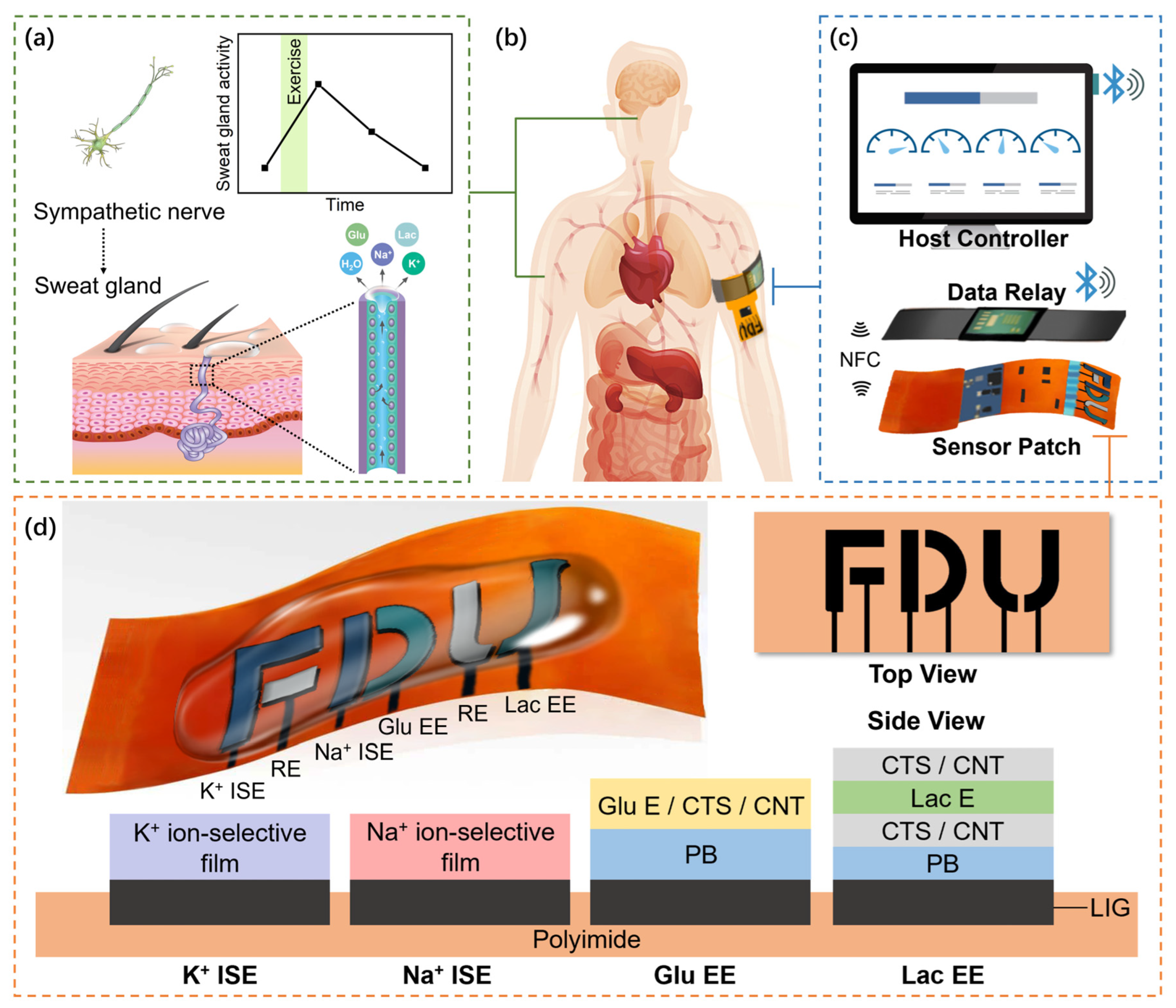
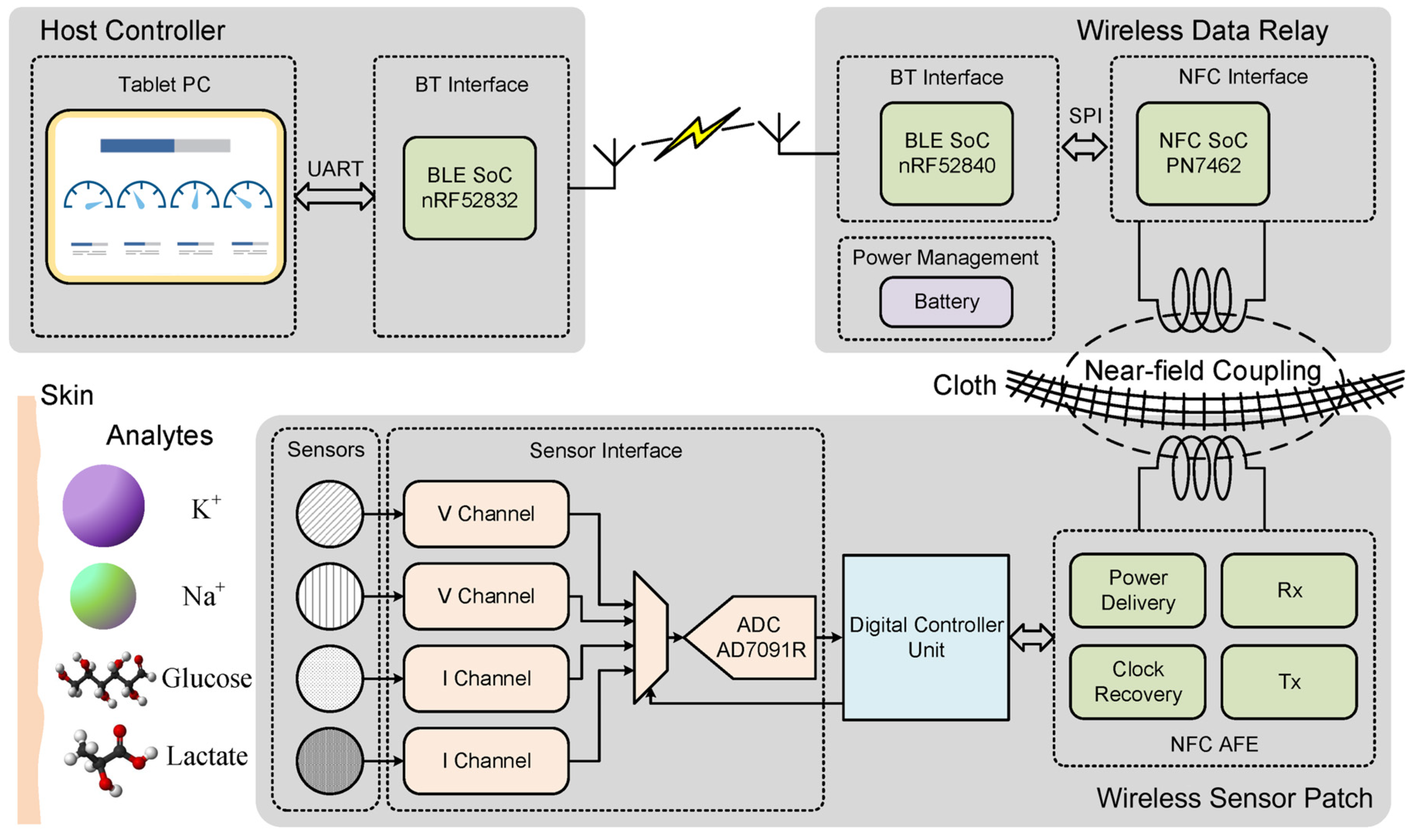



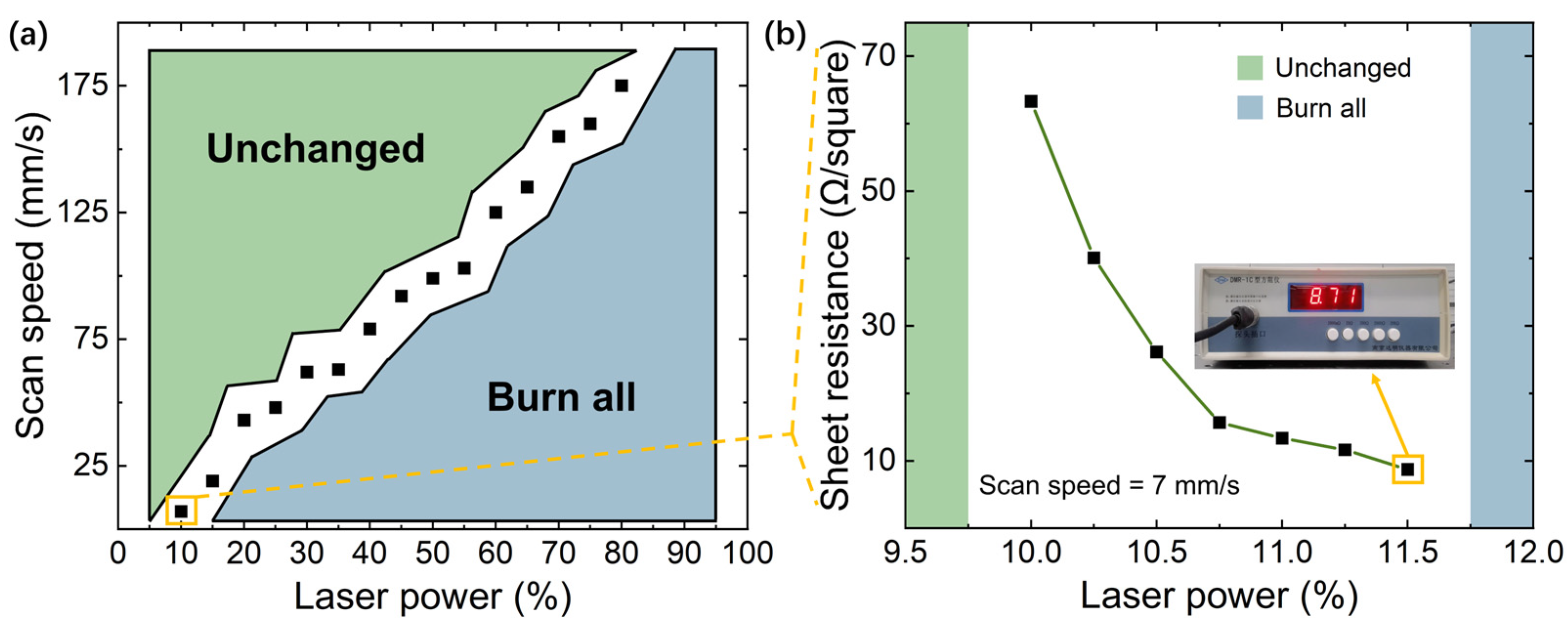
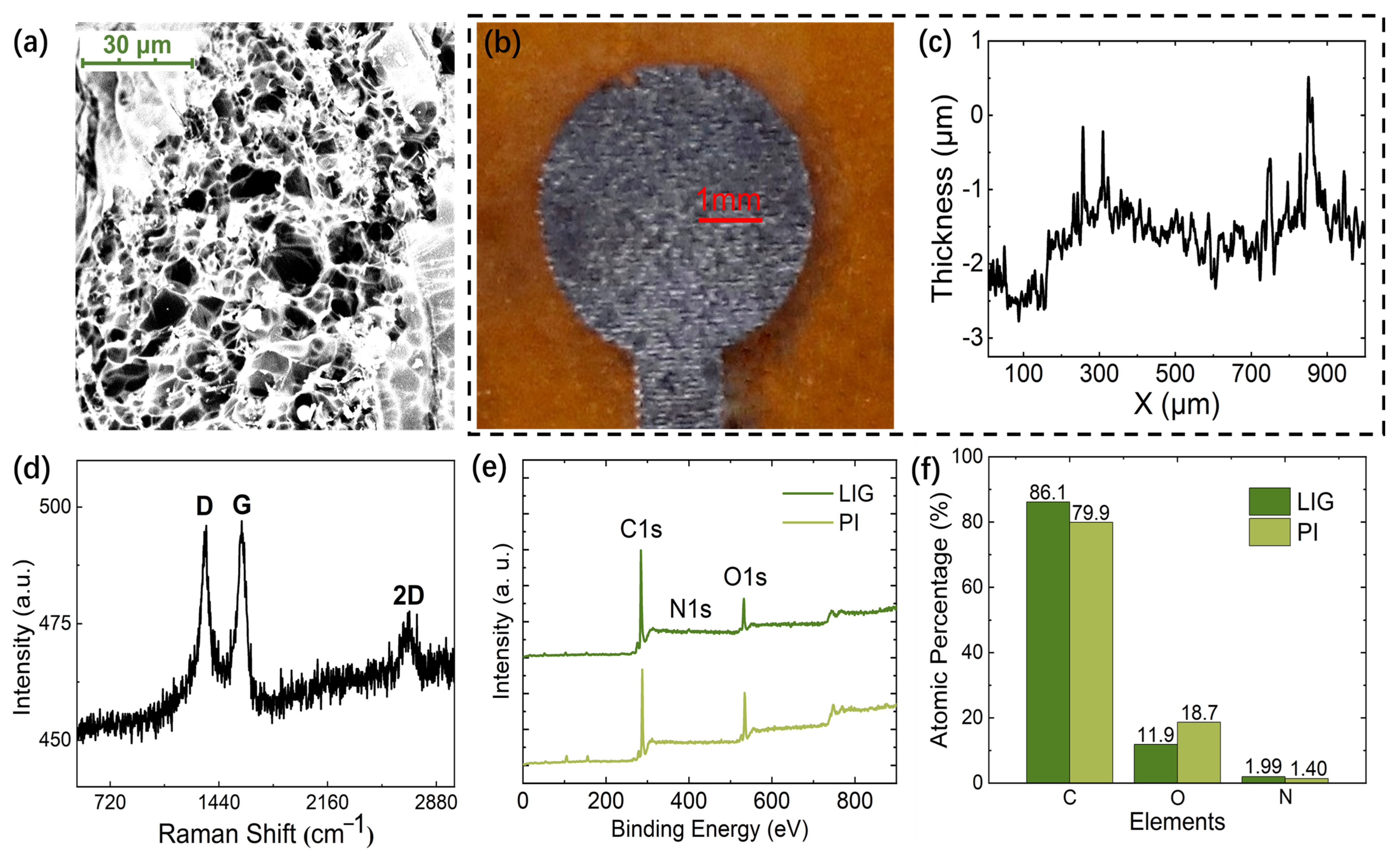
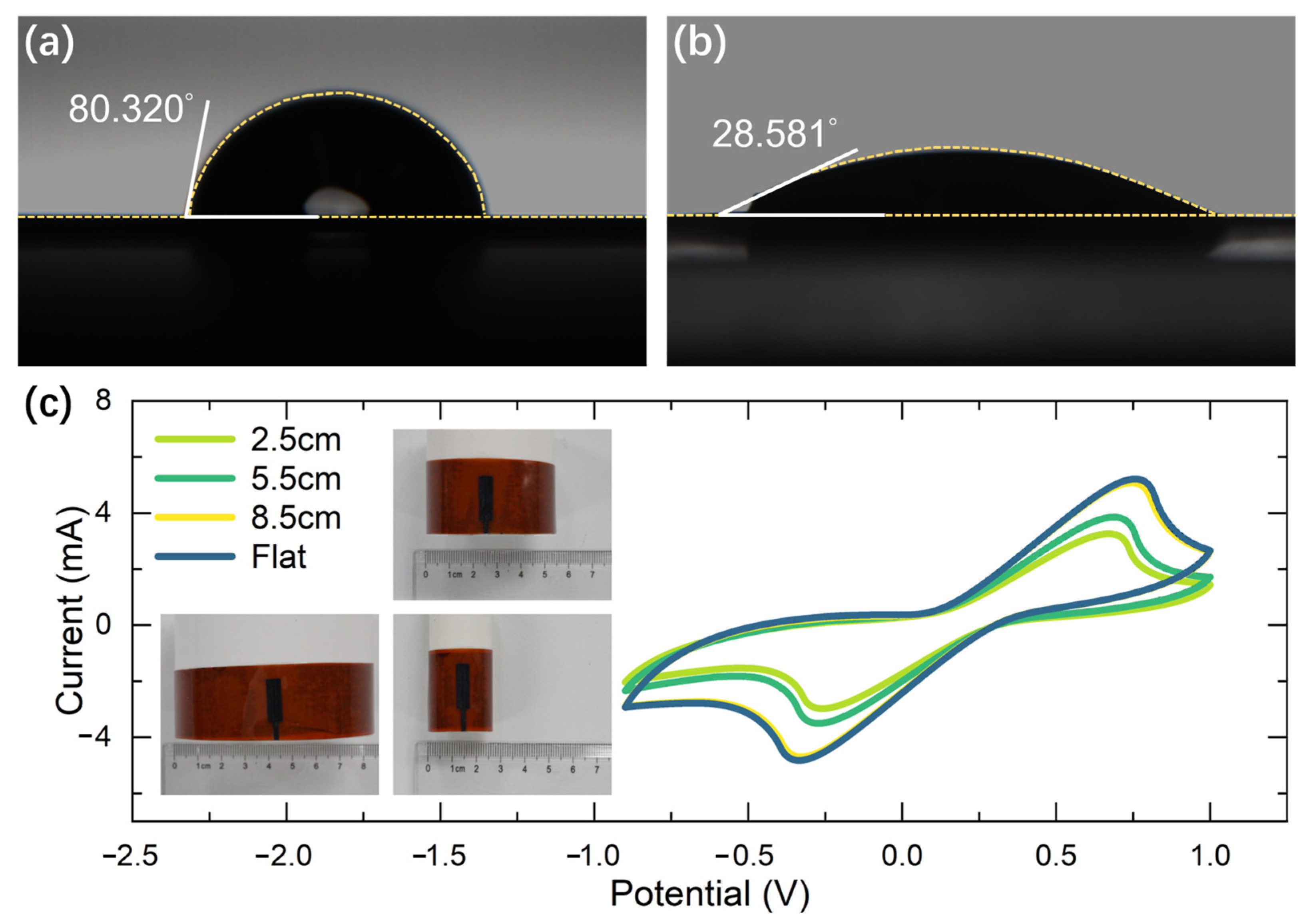
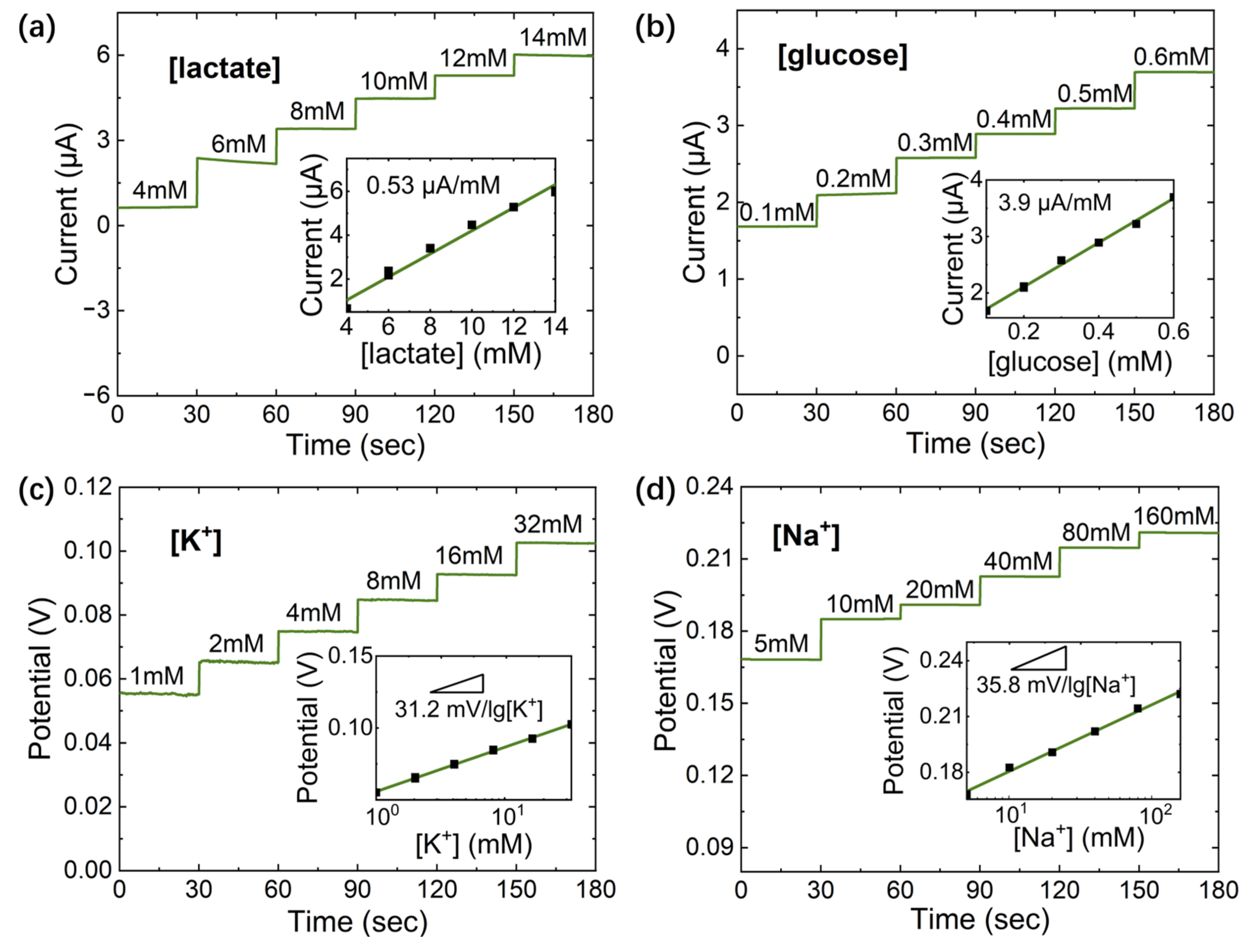


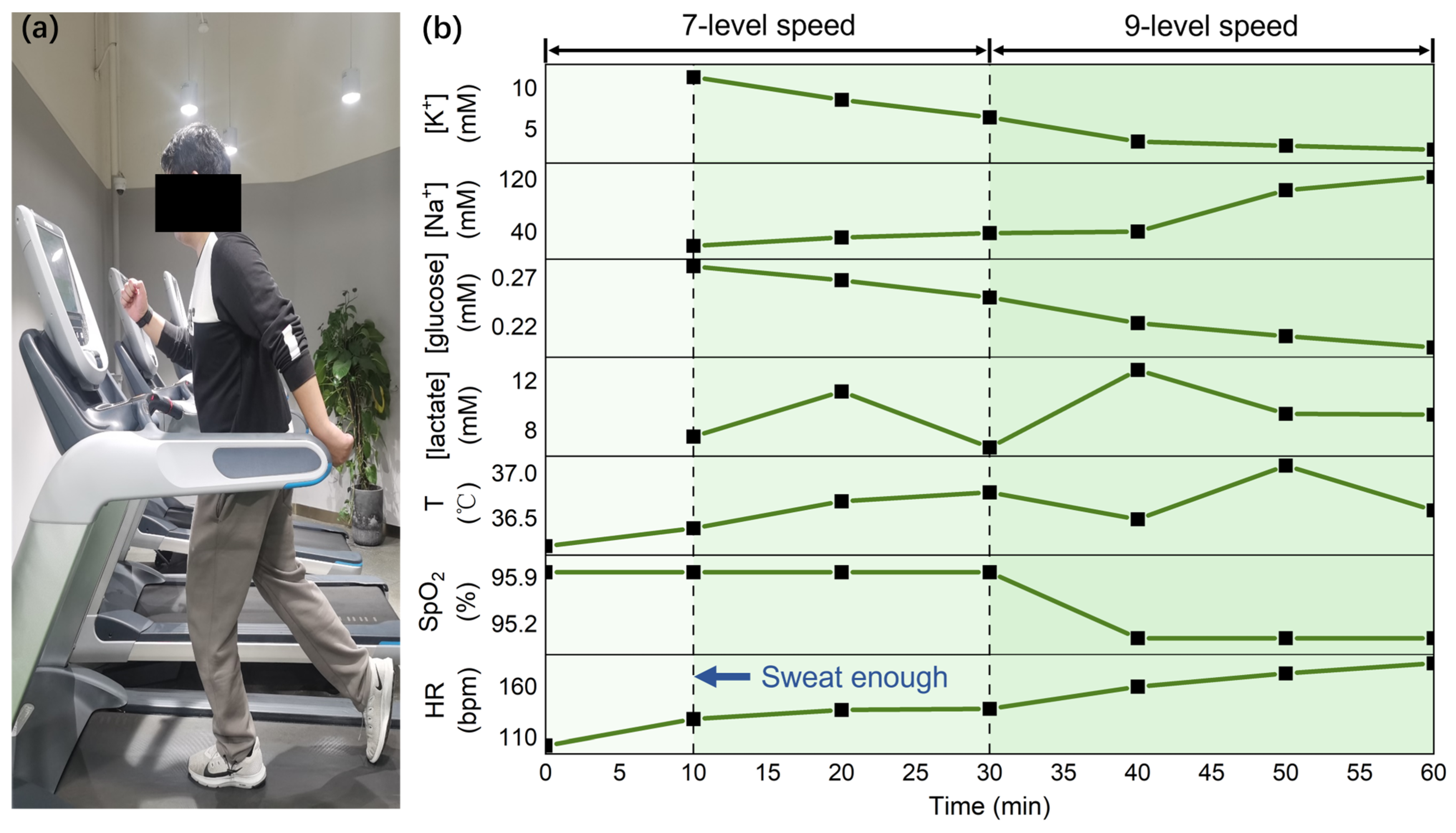
| Sensing Function | Lactate | Glucose | K+ | Na+ |
|---|---|---|---|---|
| Gain of amplifier | 510 kΩ | 510 kΩ | 3 | 3 |
| Analyte concentrations | 2.8 mM–15.8 mM | 76 μM–1.8 mM | 1 mM–32 mM | 5 mM–160 mM |
| Sensitivity of sensors | 0.53 μA/mM | 3.9 μA/mM | 31.2 mV/decade | 35.8 mV/decade |
| Sensitivity of system | 3.2 μM | 0.42 μM | 14 μM | 53 μM |
| (@ 1 mM) | (@ 10 mM) |
| Items | [18] | [24] | [25] | [38] | [39] | This Work |
|---|---|---|---|---|---|---|
| Sensing mode | V, I | V | V, I | I | V, I | V, I |
| Electrochemical sensors | K+, Na+, lactate, glucose | K+, Na+, Cl–, pH | K+, Na+, pH, glucose | Lactate | Glucose, pH, lactate, Cl−, urea | K+, Na+, lactate, glucose |
| Material | Au | Au | AgNWs * | Carbon ink | Au | LIG |
| Sensitivity of lactate | 0.22 μA/mM | - | - | 0.009 μA/mM | 0.07 μA/mM | 0.53 μA/mM |
| Sensitivity of glucose | 2.35 μA/mM | - | 0.75 μA/mM | - | 1.3 μA/mM | 3.9 μA/mM |
| Powering | Battery | Battery | NFC | Battery | NFC | NFC |
| Communication | Bluetooth | Bluetooth | NFC | Bluetooth | NFC | Bluetooth + NFC |
| Communication Distance | 6–10 m | 6–10 m | ≤0.1 m | 6–10 m | ≤0.1 m | 6–10 m |
| Texture | PCB | PCB | FPC | Polyurethane | PCB + FPC | PCB + FPC |
| Footprint | 9 × 2.7 cm2 | 8.3 × 3.2 cm2 | 3.7 × 1.5 cm2 | 6.5 × 6.5 cm2 | 6.2 × 5.7 cm2 | 4.5 × 2 cm2 |
Disclaimer/Publisher’s Note: The statements, opinions and data contained in all publications are solely those of the individual author(s) and contributor(s) and not of MDPI and/or the editor(s). MDPI and/or the editor(s) disclaim responsibility for any injury to people or property resulting from any ideas, methods, instructions or products referred to in the content. |
© 2023 by the authors. Licensee MDPI, Basel, Switzerland. This article is an open access article distributed under the terms and conditions of the Creative Commons Attribution (CC BY) license (https://creativecommons.org/licenses/by/4.0/).
Share and Cite
Feng, J.; Jiang, Y.; Wang, K.; Li, J.; Zhang, J.; Tian, M.; Chen, G.; Hu, L.; Zhan, Y.; Qin, Y. An Energy-Efficient Flexible Multi-Modal Wireless Sweat Sensing System Based on Laser Induced Graphene. Sensors 2023, 23, 4818. https://doi.org/10.3390/s23104818
Feng J, Jiang Y, Wang K, Li J, Zhang J, Tian M, Chen G, Hu L, Zhan Y, Qin Y. An Energy-Efficient Flexible Multi-Modal Wireless Sweat Sensing System Based on Laser Induced Graphene. Sensors. 2023; 23(10):4818. https://doi.org/10.3390/s23104818
Chicago/Turabian StyleFeng, Jiuqing, Yizhou Jiang, Kai Wang, Jianzheng Li, Jialong Zhang, Mi Tian, Guoping Chen, Laigui Hu, Yiqiang Zhan, and Yajie Qin. 2023. "An Energy-Efficient Flexible Multi-Modal Wireless Sweat Sensing System Based on Laser Induced Graphene" Sensors 23, no. 10: 4818. https://doi.org/10.3390/s23104818





